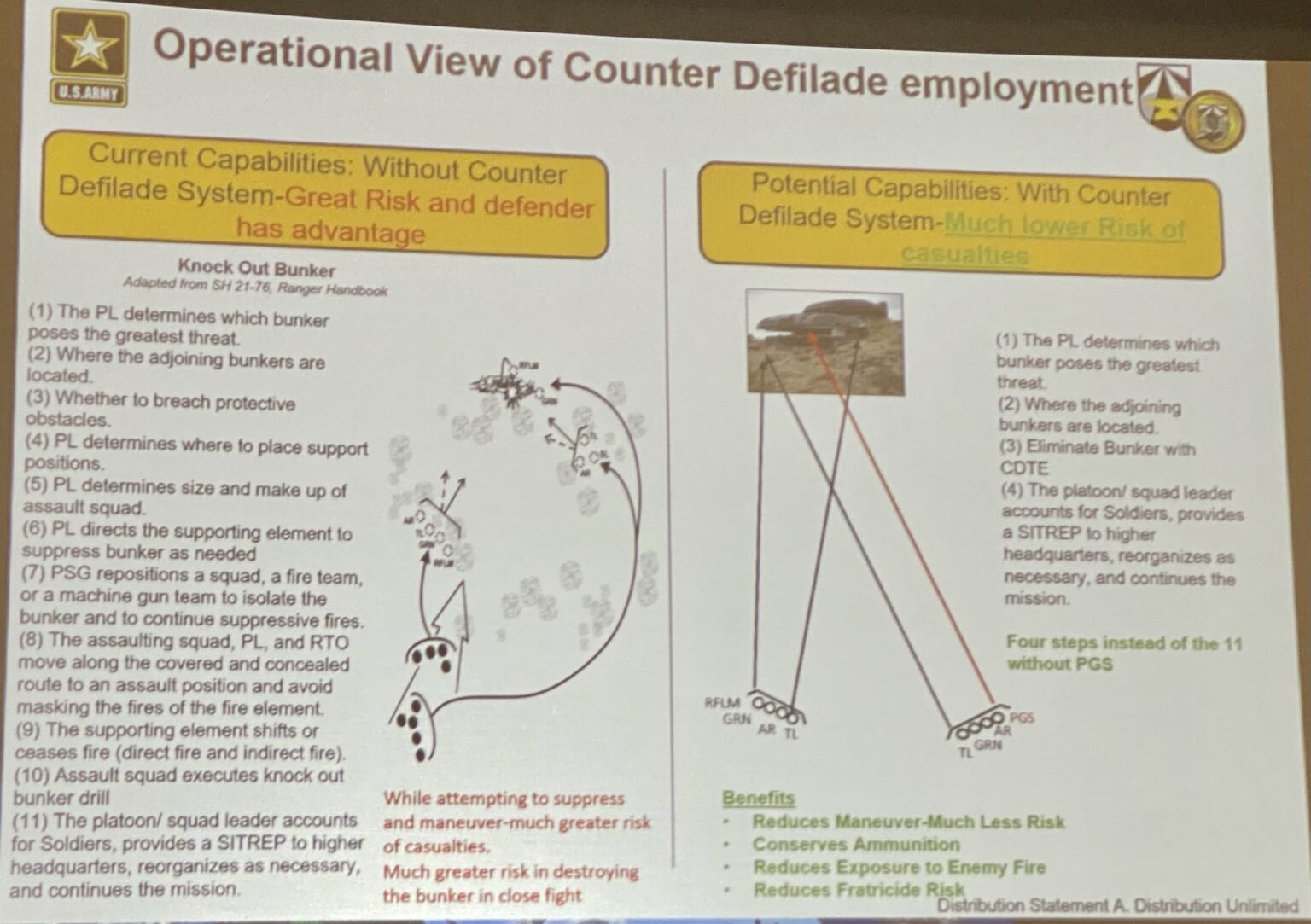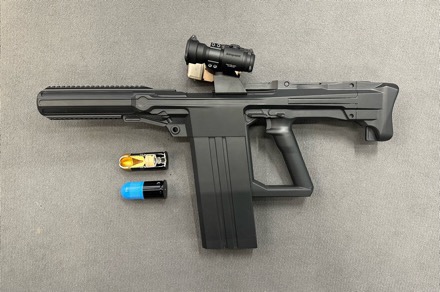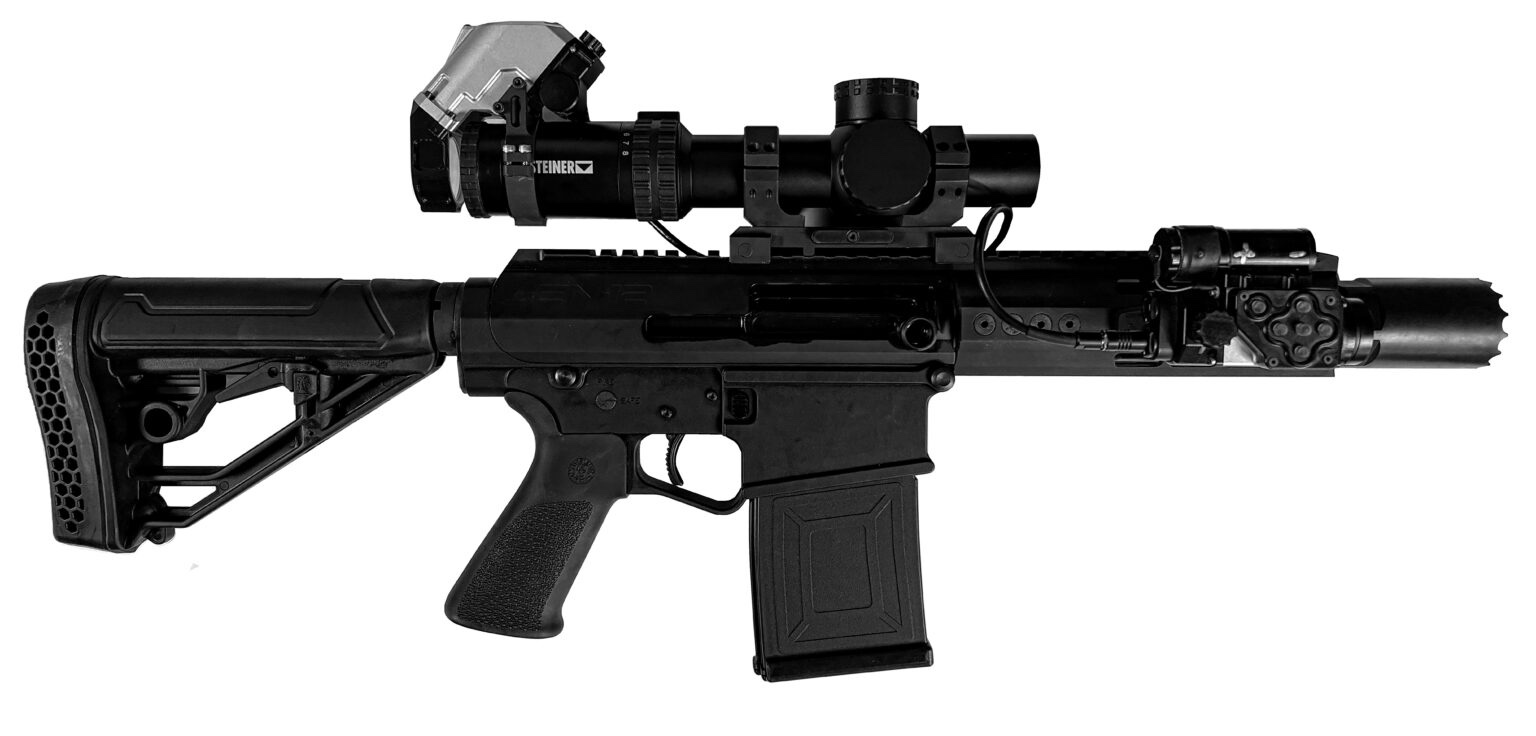
The US Army’s Precision Grenadier System effort we told you about last September is underway to handle counter defilade and counter UAS at the squad level.
The PGS shall be a Soldier portable, flat trajectory, semi-automatic, magazine fed, integrated armament system that enables precision engagements to destroy personnel targets in defilade and in the open with increased lethality and precision compared to legacy grenade launchers. The PGS is anticipated to be deployed as a Soldier’s primary weapon system and provide organic close-quarters combat and counter-defilade capabilities through a family of ammunition, providing overmatch to comparable threat grenade launchers in near-peer formations in future operating environments to include urban, woodland, subterranean, and desert, in day, night, or obscured conditions.
The Army is seeking a multi-shot grande launcher which integrates a sophisticated Fire Control System capable of programming rounds along with a family of programmable ammunition.
Family of Ammunition:
a. Counter Defilade Round: Round to precisely and quickly defeat personnel targets in defilade positions.
b. Training Round: Non-pyrotechnic round ballistically similar to the counter defilade round to train the PGS capability.
c. Close Quarters Battle Round: Round to precisely and quickly defeat personnel targets at ranges less than 35 meters.
d. Expanded Capabilities: Ability to expand capabilities is desired with different types of ammo such as:
i. Counter Unmanned Aerial System (UAS) Round
ii. Armor-Piercing Round
Naturally, this will also require a power supply.
Additionally, PGS must be lethal from distances of 35m to 500M or longer against unprotected soldiers in both the open and in cover and with a time of flight no greater than 3 seconds out to 500 meters.
It is important to note that the Army has not specified caliber, but rather effect, and has left it open to the various vendors to create the complete system.

Program Executive Office (PEO) Soldier partnered with the Assistant Secretary of the Army (Acquisition, Logistics, and Technology) (ASA(ALT)), to use the xTechSoldier Lethality competition as a platform to interact with industry.
The xTechSoldier Lethality competition consists of three-rounds:
1 Call for concept white papers;
2 Technology Pitch; and
3 Final Proof-of-Concept Demonstration
So far, we’ve seen round 1 which selected five companies based upon their white paper submissions. Each of these small businesses will receive a cash prize of $15,000 and an invitation to advance to Part 2: Technology Pitches where the teams will showcase their innovative concepts for a Precision Grenadier System (PGS):
• American Rheinmetall Munitions, “Squad Support Weapon Achieving Precision Grenadier System Objectives”
• FN America, LLC, “PGS-001”
• Knight Technical Solutions, LLC, “Multipurpose Intelligent Grenade System ‘MIGS’”
• MARS, Inc., “MARS, Inc. 30mm Support Rifle System (SRS)”
• Plumb Precision Products, LLC, “P3 M110 Precision Grenade Launcher”
Up to three companies will be selected from the virtual technology pitch round (round 2) and receive an additional $300,000 each in cash prizes and the opportunity to come back in 6 to 18 months to conduct a final proof-of-concept demonstration (round 3).
Those technology pitches are set to begin today, Aug 29, 2023 and last until Sep 1st.
One final winner may be selected and awarded up to $2M in a follow-on contract or agreement. The target for this phase is Mar 1, 2024 – Mar 31, 2025.

SSD readers may be familiar with the Rheinmetall and Plumb Precision Products system which we have covered in the past.


I am intrigued to see what the FN and MARS proposed systems look like. Meanwhile, there’s a video on YouTube from KTS that explains their system in more detail: https://www.youtube.com/watch?v=_00wrnLbJ-4
Agreed. Though the concern that I have for the Plumb and KTS entries is the same that some had over the XM-25…will the projectiles have enough payload for adequate lethality?
I’m willing to guess that FN’s will be some sort of standalone 40mm, albeit modernized, maximized for MV, and with an integrated fire control.
The naming of the MARS submission is particularly interesting though…it almost makes me think they’re going with some kind of evolution of the concept seen in Barrett’s XM109, which would lend itself to peer warfare quite well.
what happened to the xm25 “punisher”?
https://soldiersystems.net/2022/09/21/army-considering-new-capabilities-for-infantry-including-precision-grenadier-system-medium-machine-gun-mortar/
The XM25 had a habit of projectiles exploding in the barrel-albeit it was only one time but that is all that it took to cancel it.
https://special-ops.org/xm25-punisher-deadliest-infantry-weapon-us-army/#Termination
I am having some difficulty imagining a future grunt carrying both the added weight and size of the XM7 and accompanying ammo and also carrying this thing and its fancy mart ammo as well.
While the counter UAS seems to be interesting I am not so sure this will be so much better than the existing M320 that it is worth a switch. Hell, where are you gonna carry those extra 30mm or 40mm mags when you are already rocking battle rifle mags?
As for smart ammo, now we are just wasting money for no reason. M855A1 cost significantly more than M855 (green tip) with only modest terminal improvement on target. 6.8x51mm is already costing millions to build he entirely new infrastructure to manufacture it, and range expansions to support it and we haven’t even made a single round from Lake City yet. And we are also on the verge of adopting a .338Norma Magnum round for a Medium Machine gun replacement that will require similar manufacturing and infrastructure investment. All this money spent on R&D and Procurement for ammunition for the “Promise of Precision” makes me wonder if this is the best use of our defense dollars.
Hell, I just this week saw units in the field with UCP pattern IOTVs, BDU pattern JSLIST and OCP pattern uniforms driving barely functional (likely circle X’d) desert tan HMMWVs. We look like the Iraqi National Guard and yet spend billions on fancy Wonder Weapons.
It isn’t that some of the above weapons aren’t individually impressive, but it seems we have our spending priorities backwards when our Soldiers still are rocking hand-me-downs, don’t have enough PVS14s for every Soldier and don’t have enough ammo allocations to do all the required new rifle tables for qualification. Just seems backwards is all.
While I agree with your premise…M855A1 is an exceptional improvement over M855 in every way. Setting aside the fact that it works as intended in the barrel length it’s being fired out of (unlike M855), numerous open source and anecdotal reports show that M855A1 is exponentially better in terms of terminal performance than almost any other 5.56 round used in the DoD. It seems to have a much lower fragmentation threshold than the SOST rounds and a shorter neck in the wound track than Mk262. Given how long we’re going to continue having M4’s, M16’s, and other 5.56 weapons in inventory, I think the cost associated with developing and fielding A1 is worth it.
I am skeptical of the Army’s premise for NGSW (defeating hard armor that isn’t fielded by our current/near future adversaries), there is no doubt that 6.8×51 is superior to 7.62 NATO and could (and should) easily be a 1 for 1 replacement for those weapons. The 338 MG I’m split on…I absolutely see the extra capability that a weapon like that can bring, especially over less maneuverable weapons such as M2’s, but I don’t know if there’s a critical need for the extended range it brings vs 6.8×51. I understand that squads and some weapons platoons felt outraged by PK’s in Afghanistan, but 6.8 should close that minor gap. Furthermore, I don’t believe that ‘gap’ was truly the result of a lack of capability in 7.62 NATO, but more the result of the relative lack of portability of M14 EBR’s/M240’s vs Dragunov’s/PK’s. Again, the M250 closes both of those gaps quite readily.
I’ve always felt that we should lean more heavily into PDW type weapons for certain applications outside of the CCF, but also for certain roles (such as grenadiers) whose weapons and ammo load have only gotten more heavy and bulky overtime. In the case of PGS, if it can deliver the effects that the Army is hoping for, I can definitely see it being a worthy supplement to M320’s and M203’s, especially if some of the ammo paid for PGS can be split throughout the squad the way that linked 5.56/7.62/6.8 can be.
My half penny thoughts from prior involvement:
From an acquisition standpoint this is a key phrase:
” The PGS is anticipated to be deployed as a Soldier’s primary weapon system and provide organic close-quarters combat and counter-defilade capabilities through a family of ammunition, providing overmatch to comparable threat grenade launchers in near-peer formations in future operating environments to include urban, woodland, subterranean, and desert, in day, night, or obscured conditions.”
Note the “primary weapon” stipulation. What will kill this, just like the XM25 is going to be weight. You can’t retain lethality without an adequate payload. Adequate payloads take weight. You can’t beat physics. This weapon system is going to be heavy. Especially if this has to deliver lethality to a target in defilade with overhead cover/structure. A great force multiplier that can be humped or stowed on a vehicle, especially if they can work it into a capable counter UAV solution. However, if they really wanted to procure this system they would have removed the individual “primary weapon” requirement. It is my guess that they want more funding to continue to develop XM25: Part Deux. If somehow it does get acquired this time around, I would hate to be the guy assigned as the PGS primary.